- Calendar
- Online Ticket Sales
- Access
- JA
- EN
The 50th anniversary of the Suntory Foundation for the Arts
Mino Tea Wares: Kiseto, Setoguro, Shino, and Oribe
September 4 to November 10, 2019
*There will be an exhibition change during the course of exhibition
*Download the list of changes in works on display
The list of changes in worksPDF
Section 1
Tea Ware Creation in Mino
The Momoyama period Mino wares that are the stars of this exhibition were created in the area centering on the present-day cities of Kani, Tajimi, Toki and Mizunami in Gifu prefecture. The long history of ceramic kilns in this area dates to Sue ware production in the 7th century. Kiln operations have continued ever since, with many still active today.
The four different Mino ware types known as Kiseto, Setoguro, Shino and Oribe flourished one after the other in the late 16th to early 17th centuries. Each type forms part of the uniquely creative, powerful beauty of Mino tea wares.
This section introduces the artistic fascination of richly creative Kiseto, Setoguro, Shino and Oribe tea wares through the following key attributes: borrowed forms; painted; warped; and mold-formed.
Borrowed Forms
The Mino kilns are known for having produced works that seem to have borrowed the forms of other artworks, such as the pre-Momoyama period Chinese ceramics and lacquer works that were prized in Japan. And yet these were by no means faithful copies, rather, they were interpretations that created new forms of tea ware.
Painted
Among the main Momoyama period Japanese-produced tea wares, such as those made at the Iga, Karatsu, Shigaraki and Bizen kilns, Mino ware stands out as a highly decorative ceramic form, enhanced by various decorating methods.
For example, Kiseto tea bowls, bowls, and mukozuke dishes are decorated with flowingline incisions creating vining plant, flowers and grasses motifs, which were then all enlivened by the placement of green (chalcanthite) and brown (iron oxide) pigments on top of an elegant yellowish toned glaze.
Shino and Oribe tea bowls, mizusashi (fresh-water jars), incense containers, bowls and mukozuke dishes were decorated with expansive designs in underglaze iron painting known as tetsu-e, literally iron painting. These underglaze iron designs introduced to ceramics a touch of the gorgeous adornment found in Japanese maki-e lacquer and textiles.
Warped
The warping, deformation and misshapen forms seen in Kiseto, Shino and Oribe tea bowls, and Shino and Oribe vases and fresh-water jars were all created by removing a wet clay shape from the potter’s wheel and either using a spatula to carve complex planes into the wheel-thrown form or pinching it into a misshapen form. These warped shapes all share an aesthetic found throughout Momoyama period Japanese tea wares, such as those made in the Iga, Karatsu, Shigaraki and Bizen kilns. This process also imbues each specific work with its own power and individuality.
Mold-Formed
In mold-formed techniques, a potter takes a wheel-thrown form or a slab of kneaded clay and presses it into a mold to create a vessel. Not only does this allow for the mass production of works, it also liberates the vessel shape range from the circular or cylindrical. Indeed, it can be considered an epoque-making technique that allowed potters to realize free-formed shapes. This section introduces some of the clay molds used in this techniques, along with myriad bowls, boxes with lids and mukozuke dishes that scholars today believe were mold-made.
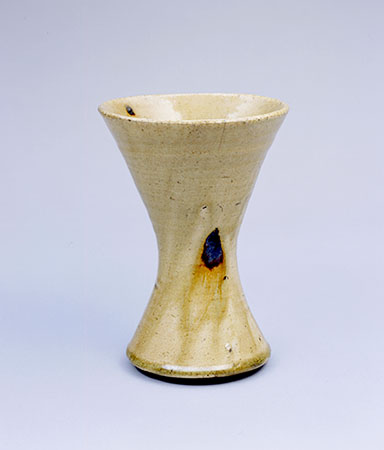
Momoyama period, 16th–17th centuries
Suntory Museum of Art
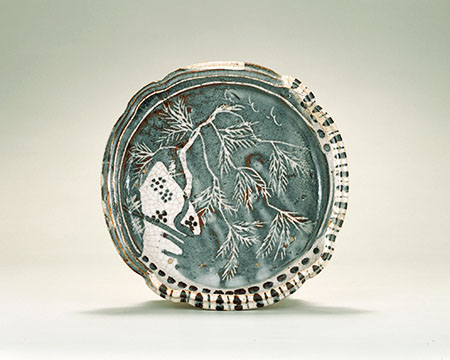
Momoyama period, 16th–17th centuries
Suntory Museum of Art
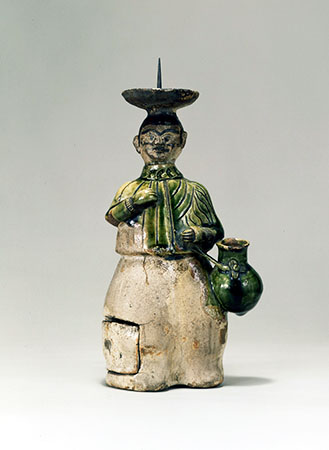
Momoyama period, 17th century
Suntory Museum of Art
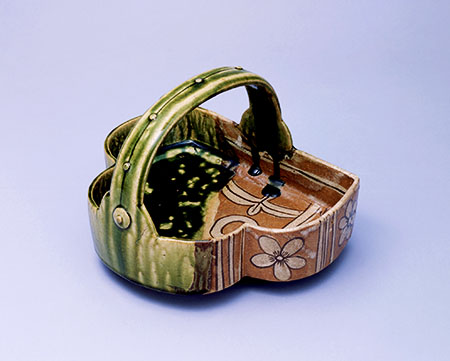
Momoyama period, 17th century
Suntory Museum of Art
Section 2
The Shōwa Era Mino Ware Revival
Mino ware grew in popularity and regard from the modern era onwards. This section explores that development by displaying works formerly owned by wealthy modern era private collectors known as sukisha, and through the introduction of major works by two modern ceramic artists who turned to the Momoyama era Mino ware aesthetic as a means of enriching their own artistic expression.
1. Arakawa Toyozō and Katō Tōkurō
– Ceramic Artists Who Took on Mino Ware Aesthetics as a Creative Challenge
This section introduces major works by Arakawa Toyozō (1894-1985) and Katō Tōkurō (1897–1985), two ceramic artists who passionately studied old Mino wares, and through an ongoing trial and error process enriched their own ceramic creations with the spirit and aesthetics of Momoyama period Mino wares.
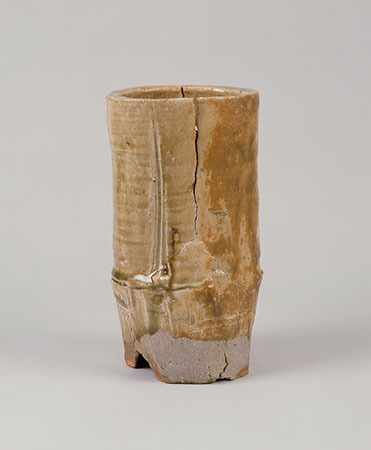
Arakawa Toyozō
Shōwa period, dated 1958
Aichi Prefectural Ceramic Museum (Gift of Kawasaki Otozō)
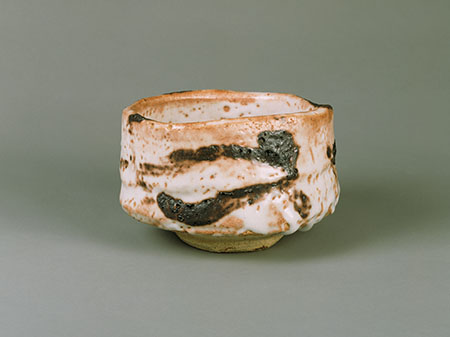
Katō Tōkurō
Shōwa period, dated 1969
Aichi Prefectural Ceramic Museum (Gift of Kawasaki Otozō)
2. Modern Sukisha and Mino Ware
– The Selecting and Preserving of Masterpieces
The term sukisha refers to individuals whose interest in the Japanese tea ceremony led them to use their extensive personal fortunes to acquire tea utensil masterworks and develop their own personal tea ceremony styles and aesthetics. These men were varied in their origins; some were powerful figures in the realms of politics, government and finance, while others were intellectuals and members of the cultural elite. A succession of Mino wares entered these sukisha collections in the 20th century. One such collector, Morikawa Nyoshun’an (1887–1980) was a major Nagoya sukisha who fervently studied Mino wares and photographed known Mino ware masterpieces of the day. He published these, along with images of works in his own collection, in the 1936 book Shino Kiseto Oribe. This book introduced the fascination of Mino wares to the wider public and remains today one of the benchmark works in the evaluation of Mino ware. This display presents works illustrated in Shino Kiseto Oribe, as well as Mino ware masterpieces formerly in modern sukisha collections.
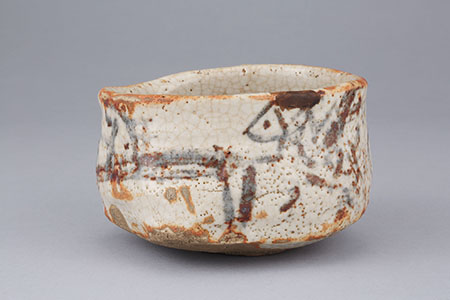
Momoyama period, 16th–17th centuries
Kosetsu Museum of Art
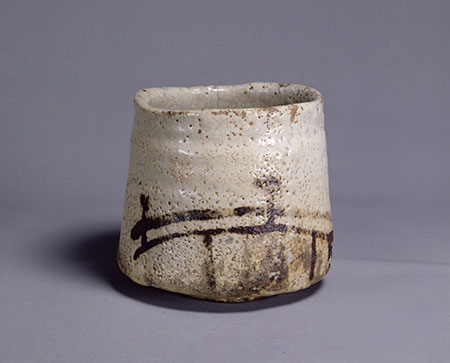
Momoyama period, 16th–17th centuries
Tokyo National Museum, Image: TNM Image Archives
*Unauthorized reproduction or use of texts or images from this site is prohibited.
2025 January
- Exhibition
- Closed
- Tea Ceremony
- Mon
- Tue
- Wed
- Thu
- Fri
- Sat
- Sun
- 1
- 2
- 3
- 4
- 5
- 6
- 7
- 8
- 9
- 10
- 11
- 12
- 13
- 14
- 15
- 16
- 17
- 18
- 19
- 20
- 21
- 22
- 23
- 24
- 25
- 26
- 27
- 28
- 29
- 30
- 31
2025 February
- Exhibition
- Closed
- Tea Ceremony
- Mon
- Tue
- Wed
- Thu
- Fri
- Sat
- Sun
- 1
- 2
- 3
- 4
- 5
- 6
- 7
- 8
- 9
- 10
- 11
- 12
- 13
- 14
- 15
- 16
- 17
- 18
- 19
- 20
- 21
- 22
- 23
- 24
- 25
- 26
- 27
- 28
2025 March
- Exhibition
- Closed
- Tea Ceremony
- Mon
- Tue
- Wed
- Thu
- Fri
- Sat
- Sun
- 1
- 2
- 3
- 4
- 5
- 6
- 7
- 8
- 9
- 10
- 11
- 12
- 13
- 14
- 15
- 16
- 17
- 18
- 19
- 20
- 21
- 22
- 23
- 24
- 25
- 26
- 27
- 28
- 29
- 30
- 31
2025 April
- Exhibition
- Closed
- Tea Ceremony
- Mon
- Tue
- Wed
- Thu
- Fri
- Sat
- Sun
- 1
- 2
- 3
- 4
- 5
- 6
- 7
- 8
- 9
- 10
- 11
- 12
- 13
- 14
- 15
- 16
- 17
- 18
- 19
- 20
- 21
- 22
- 23
- 24
- 25
- 26
- 27
- 28
- 29
- 30
2025 May
- Exhibition
- Closed
- Tea Ceremony
- Mon
- Tue
- Wed
- Thu
- Fri
- Sat
- Sun
- 1
- 2
- 3
- 4
- 5
- 6
- 7
- 8
- 9
- 10
- 11
- 12
- 13
- 14
- 15
- 16
- 17
- 18
- 19
- 20
- 21
- 22
- 23
- 24
- 25
- 26
- 27
- 28
- 29
- 30
- 31
2025 June
- Exhibition
- Closed
- Tea Ceremony
- Mon
- Tue
- Wed
- Thu
- Fri
- Sat
- Sun
- 1
- 2
- 3
- 4
- 5
- 6
- 7
- 8
- 9
- 10
- 11
- 12
- 13
- 14
- 15
- 16
- 17
- 18
- 19
- 20
- 21
- 22
- 23
- 24
- 25
- 26
- 27
- 28
- 29
- 30
2025 July
- Exhibition
- Closed
- Tea Ceremony
- Mon
- Tue
- Wed
- Thu
- Fri
- Sat
- Sun
- 1
- 2
- 3
- 4
- 5
- 6
- 7
- 8
- 9
- 10
- 11
- 12
- 13
- 14
- 15
- 16
- 17
- 18
- 19
- 20
- 21
- 22
- 23
- 24
- 25
- 26
- 27
- 28
- 29
- 30
- 31
2025 August
- Exhibition
- Closed
- Tea Ceremony
- Mon
- Tue
- Wed
- Thu
- Fri
- Sat
- Sun
- 1
- 2
- 3
- 4
- 5
- 6
- 7
- 8
- 9
- 10
- 11
- 12
- 13
- 14
- 15
- 16
- 17
- 18
- 19
- 20
- 21
- 22
- 23
- 24
- 25
- 26
- 27
- 28
- 29
- 30
- 31
2025 September
- Exhibition
- Closed
- Tea Ceremony
- Mon
- Tue
- Wed
- Thu
- Fri
- Sat
- Sun
- 1
- 2
- 3
- 4
- 5
- 6
- 7
- 8
- 9
- 10
- 11
- 12
- 13
- 14
- 15
- 16
- 17
- 18
- 19
- 20
- 21
- 22
- 23
- 24
- 25
- 26
- 27
- 28
- 29
- 30
2025 October
- Exhibition
- Closed
- Tea Ceremony
- Mon
- Tue
- Wed
- Thu
- Fri
- Sat
- Sun
- 1
- 2
- 3
- 4
- 5
- 6
- 7
- 8
- 9
- 10
- 11
- 12
- 13
- 14
- 15
- 16
- 17
- 18
- 19
- 20
- 21
- 22
- 23
- 24
- 25
- 26
- 27
- 28
- 29
- 30
- 31
2025 November
- Exhibition
- Closed
- Tea Ceremony
- Mon
- Tue
- Wed
- Thu
- Fri
- Sat
- Sun
- 1
- 2
- 3
- 4
- 5
- 6
- 7
- 8
- 9
- 10
- 11
- 12
- 13
- 14
- 15
- 16
- 17
- 18
- 19
- 20
- 21
- 22
- 23
- 24
- 25
- 26
- 27
- 28
- 29
- 30
2025 December
- Exhibition
- Closed
- Tea Ceremony
- Mon
- Tue
- Wed
- Thu
- Fri
- Sat
- Sun
- 1
- 2
- 3
- 4
- 5
- 6
- 7
- 8
- 9
- 10
- 11
- 12
- 13
- 14
- 15
- 16
- 17
- 18
- 19
- 20
- 21
- 22
- 23
- 24
- 25
- 26
- 27
- 28
- 29
- 30
- 31
2026 January
- Exhibition
- Closed
- Tea Ceremony
- Mon
- Tue
- Wed
- Thu
- Fri
- Sat
- Sun
- 1
- 2
- 3
- 4
- 5
- 6
- 7
- 8
- 9
- 10
- 11
- 12
- 13
- 14
- 15
- 16
- 17
- 18
- 19
- 20
- 21
- 22
- 23
- 24
- 25
- 26
- 27
- 28
- 29
- 30
- 31
2026 February
- Exhibition
- Closed
- Mon
- Tue
- Wed
- Thu
- Fri
- Sat
- Sun
- 1
- 2
- 3
- 4
- 5
- 6
- 7
- 8
- 9
- 10
- 11
- 12
- 13
- 14
- 15
- 16
- 17
- 18
- 19
- 20
- 21
- 22
- 23
- 24
- 25
- 26
- 27
- 28
2026 March
- Exhibition
- Closed
- Mon
- Tue
- Wed
- Thu
- Fri
- Sat
- Sun
- 1
- 2
- 3
- 4
- 5
- 6
- 7
- 8
- 9
- 10
- 11
- 12
- 13
- 14
- 15
- 16
- 17
- 18
- 19
- 20
- 21
- 22
- 23
- 24
- 25
- 26
- 27
- 28
- 29
- 30
- 31
2026 April
- Exhibition
- Closed
- Mon
- Tue
- Wed
- Thu
- Fri
- Sat
- Sun
- 1
- 2
- 3
- 4
- 5
- 6
- 7
- 8
- 9
- 10
- 11
- 12
- 13
- 14
- 15
- 16
- 17
- 18
- 19
- 20
- 21
- 22
- 23
- 24
- 25
- 26
- 27
- 28
- 29
- 30
2026 May
- Exhibition
- Closed
- Mon
- Tue
- Wed
- Thu
- Fri
- Sat
- Sun
- 1
- 2
- 3
- 4
- 5
- 6
- 7
- 8
- 9
- 10
- 11
- 12
- 13
- 14
- 15
- 16
- 17
- 18
- 19
- 20
- 21
- 22
- 23
- 24
- 25
- 26
- 27
- 28
- 29
- 30
- 31
2026 June
- Exhibition
- Closed
- Mon
- Tue
- Wed
- Thu
- Fri
- Sat
- Sun
- 1
- 2
- 3
- 4
- 5
- 6
- 7
- 8
- 9
- 10
- 11
- 12
- 13
- 14
- 15
- 16
- 17
- 18
- 19
- 20
- 21
- 22
- 23
- 24
- 25
- 26
- 27
- 28
- 29
- 30
2026 July
- Exhibition
- Closed
- Mon
- Tue
- Wed
- Thu
- Fri
- Sat
- Sun
- 1
- 2
- 3
- 4
- 5
- 6
- 7
- 8
- 9
- 10
- 11
- 12
- 13
- 14
- 15
- 16
- 17
- 18
- 19
- 20
- 21
- 22
- 23
- 24
- 25
- 26
- 27
- 28
- 29
- 30
- 31
2026 August
- Exhibition
- Closed
- Mon
- Tue
- Wed
- Thu
- Fri
- Sat
- Sun
- 1
- 2
- 3
- 4
- 5
- 6
- 7
- 8
- 9
- 10
- 11
- 12
- 13
- 14
- 15
- 16
- 17
- 18
- 19
- 20
- 21
- 22
- 23
- 24
- 25
- 26
- 27
- 28
- 29
- 30
- 31
2026 September
- Exhibition
- Closed
- Mon
- Tue
- Wed
- Thu
- Fri
- Sat
- Sun
- 1
- 2
- 3
- 4
- 5
- 6
- 7
- 8
- 9
- 10
- 11
- 12
- 13
- 14
- 15
- 16
- 17
- 18
- 19
- 20
- 21
- 22
- 23
- 24
- 25
- 26
- 27
- 28
- 29
- 30
2026 October
- Exhibition
- Closed
- Mon
- Tue
- Wed
- Thu
- Fri
- Sat
- Sun
- 1
- 2
- 3
- 4
- 5
- 6
- 7
- 8
- 9
- 10
- 11
- 12
- 13
- 14
- 15
- 16
- 17
- 18
- 19
- 20
- 21
- 22
- 23
- 24
- 25
- 26
- 27
- 28
- 29
- 30
- 31
2026 November
- Exhibition
- Closed
- Mon
- Tue
- Wed
- Thu
- Fri
- Sat
- Sun
- 1
- 2
- 3
- 4
- 5
- 6
- 7
- 8
- 9
- 10
- 11
- 12
- 13
- 14
- 15
- 16
- 17
- 18
- 19
- 20
- 21
- 22
- 23
- 24
- 25
- 26
- 27
- 28
- 29
- 30
2026 December
- Exhibition
- Closed
- Mon
- Tue
- Wed
- Thu
- Fri
- Sat
- Sun
- 1
- 2
- 3
- 4
- 5
- 6
- 7
- 8
- 9
- 10
- 11
- 12
- 13
- 14
- 15
- 16
- 17
- 18
- 19
- 20
- 21
- 22
- 23
- 24
- 25
- 26
- 27
- 28
- 29
- 30
- 31
